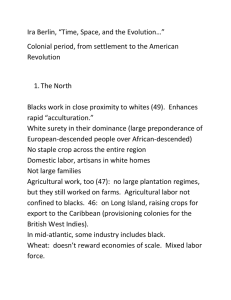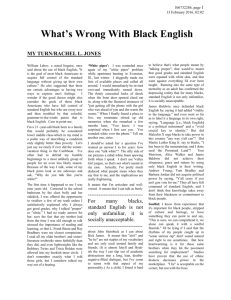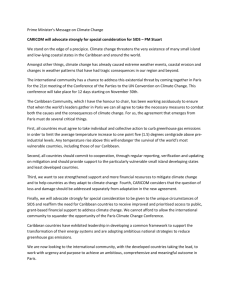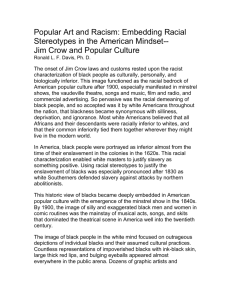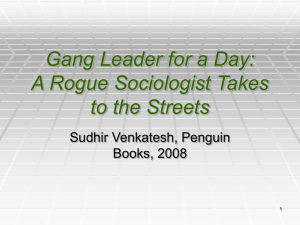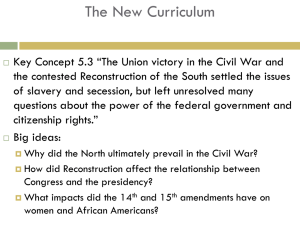Link to paper
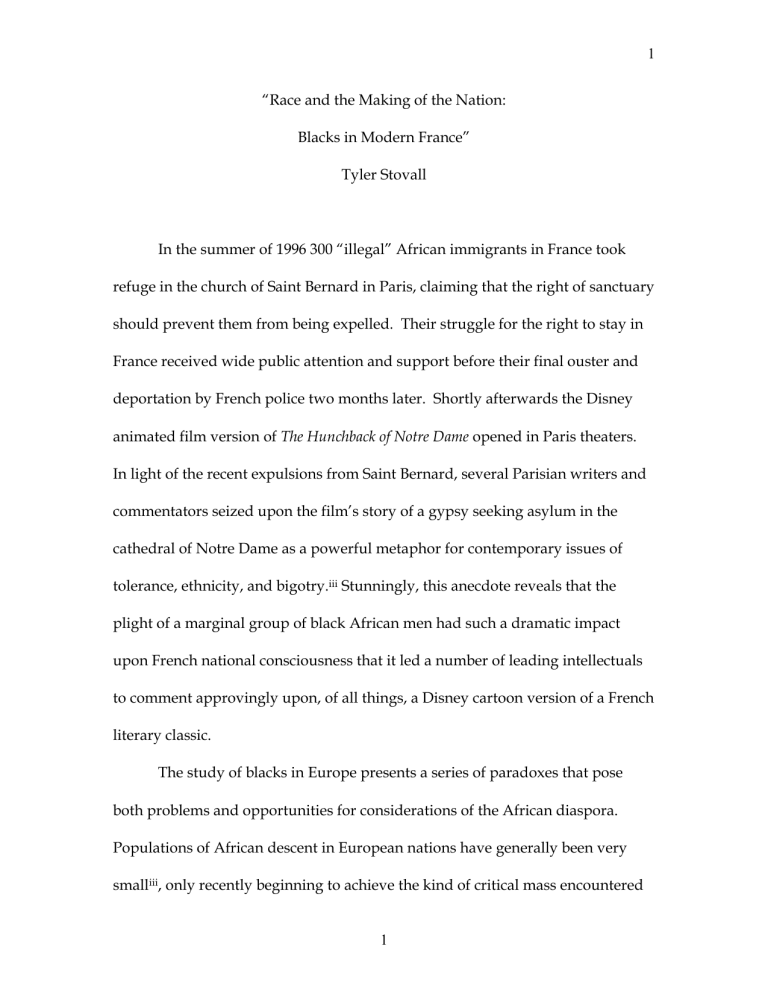
1
“Race and the Making of the Nation:
Blacks in Modern France”
Tyler Stovall
In the summer of 1996 300 “illegal” African immigrants in France took refuge in the church of Saint Bernard in Paris, claiming that the right of sanctuary should prevent them from being expelled. Their struggle for the right to stay in
France received wide public attention and support before their final ouster and deportation by French police two months later. Shortly afterwards the Disney animated film version of The Hunchback of Notre Dame opened in Paris theaters.
In light of the recent expulsions from Saint Bernard, several Parisian writers and commentators seized upon the film’s story of a gypsy seeking asylum in the cathedral of Notre Dame as a powerful metaphor for contemporary issues of tolerance, ethnicity, and bigotry.
iii Stunningly, this anecdote reveals that the plight of a marginal group of black African men had such a dramatic impact upon French national consciousness that it led a number of leading intellectuals to comment approvingly upon, of all things, a Disney cartoon version of a French literary classic.
The study of blacks in Europe presents a series of paradoxes that pose both problems and opportunities for considerations of the African diaspora.
Populations of African descent in European nations have generally been very small iii , only recently beginning to achieve the kind of critical mass encountered
1
2 in many areas of the Americas.
iv This demographic fact contributes to a broader conceptual issue, the widespread perception of Europe as the white continent, racially homogeneous and naturally counterposed both to the dark continent of
Africa and to the melting pot of America. References to courses about European history as the study of dead white males are only one common manifestation of this belief. At the same time, one cannot claim that Europeans have had no contact with blacks until recent years: whether or not Africans existed in Europe,
Europe certainly has played a major role in Africa. It is not merely true that the central aspect of the African diaspora, the trans-Atlantic slave trade, was largely a European creation, nor that European nations colonized large parts of Africa in the modern era. More fundamentally, Europeans to a significant extent created the very notion of what it means to be black in the modern world.
v Ideas of blackness cannot of course be separated from ideas of whiteness, so that
European meditations upon the African Other also shaped the self-identity of the
“white” continent. Long before large numbers of peoples of African descent settled in Europe during the twentieth century, blackness existed as a part of the
European imagination.
vi
This paradox between a small demographic presence and a significant cultural impact suggests, I would argue, certain methodological imperatives for the study of the African diaspora in Europe. In order to comprehend this phenomenon to the fullest, one must consider both the lives and experiences of blacks in different European societies, and the representations of blackness
2
3 created by other Europeans based upon a wide variety of experiences, personal, cultural, and political. In short, the techniques of both social history and cultural studies must be brought to bear upon this subject. Moreover, as is the case with the African diaspora in general, the experiences of blacks in Europe suggest both parallels and contrasts with the experiences of blacks in other parts of the world.
European black populations have often been unusually diverse, bringing together peoples from Africa, the Caribbean, and the United States. In exploring such diversity scholars must examine how black cultures have been shaped both by their origins and by their contemporary circumstances. The very notion of blackness will therefore differ from place to place, creating divergent perspectives upon the nature of the African diaspora.
vii
In this paper I will present an overview of the history of the African diaspora in modern France. This is of course a brief sketch rather than an indepth analysis, one that will almost certainly raise more questions than it resolves. The presence of blacks on French soil can be traced back to the Roman era, although virtually nothing is known about their history before the eighteenth century.
viii Most of France’s black history has centered around two essential themes: 1) Colonial encounters and representations, from the slave trade and Caribbean plantations of the 17 th and 18 th centuries to the colonization of sub-Saharan African in the 19 th and 20 th ; and 2) Postcolonial migrations and settlements, primarily (but not only) during the twentieth century and especially after 1945. Yet in line with the research agenda outlined above, it is not enough
3
4 simply to chronicle the story of black life in France. In order to contribute significantly to the study of the African diaspora one must investigate what is unique about that experience in comparative perspective. Or, to put it another way, given the importance of national cultures in the modern age what is particularly French about blacks in France?
ix
There are many ways to approach such a question. I have chosen to do so here by focusing on one characteristic of French life not only important for blacks but key to national identity. That is the concept of the nation itself. The French have probably done more than any other people in the Atlantic world to develop the idea of the modern nation. This concept has been both civil and juridical, emphasizing the nation as a legal, contractual entity, and organic, portraying it as a linguistic, historical, and cultural presence.
x In considering the history of blacks in modern France, this essay will briefly explore it over three centuries, from the 18 th to the 20 th . It will argue that the ambivalence between civil and cultural constructs of the nation so key to the modern French experience has not only shaped black life in France, but also to an important degree arises out of
France’s black history. Furthermore, this ambivalence has intertwined concepts of nation and race in such a way as to give France’s peoples of African descent a distinctive racial profile in the context of the broader African diaspora.
The Eighteenth Century
4
5
From the standpoint of France’s black history, the eighteenth century is one of paradoxes. The era of the Enlightenment also witnessed the birth of scientific racism. The triumphant crusade against feudalism went hand in hand with the high point of the African slave trade. In addition, whereas the black population in metropolitan France only amounted to a few thousand people, during the 18 th century the nation extended its control over large populations of
African descent in the Caribbean. Moreover, blackness itself became a subdued yet significant issue in the creation of French identity, as France began its difficult transition from a kingdom of subjects to a nation of citizens.
xi
Well before the age of Enlightenment the French had developed widespread, overwhelmingly negative images of Africans. Stereotypes inherited from the ancient Greeks and Romans, and travellers’ tales like those of Leo
Africanus in the 16 th century, created a generally accepted view of Africans as people whose black skins denoted stupidity, depravity, and barbarism. French interest in blacks increased sharply during the 18 th century, part of the fascination displayed by French intellectuals in particular with non-European cultures. Although the philosophes of the Enlightenment paid more attention to
Asians and native Americans, they also began to investigate the condition of blacks. Yet since very few French intellectuals actually travelled to Africa, they tended to base their views of that continent upon pre-existing stereotypes. This is not to say, however, that the Enlightenment contributed nothing new to
French images of blacks. On the contrary, that intellectual movement gave a new
5
6 foundation to racial thinking, systematically developing ideas about the biological bases of different human races. In particular, the Enlightenment transformed the notion of the Great Chain of Being into a racial hierarchy, with
Europeans at the top and Africans almost always at the bottom of the evolutionary scale. For example, in 1797 the biologist Georges Cuvier wrote that blacks resembled monkeys, arguing that the black race had “always remained in the most complete state of utter barbarism”.
xii
The heightened interest of 18 th century French men and women arose less from scientific curiosity and more from expanded contact and conquest. Also less so than the British, the French participated extensively, and profitably, in the
Atlantic slave trade. During the 1700s more than three thousand French ships transported over a million men, women, and children from Africa to slavery in the Americas. By the end of the century roughly one out of every eight people in
France earned their living from the colonial slave trade.
xiii One of the nation’s leading port cities, Nantes, was widely known as the city of slavers.
xiv The development of the French slave trade was intimately linked with the rise of a plantation slave economy in the French Caribbean. Although France had begun its imperial expansion there in the 17 th century, it was not until the beginnings of the 18 th century that the islands of Martinique, Guadeloupe, and above all Saint
Domingue became full-fledged plantation economies based upon African slavery. For the first time in French history, the French flag flew over territories
6
7 where all aspects of economic, social, and political life were governed by considerations of racial difference.
xv
In spite of their distance from metropolitan France, the profitability and extent of the slave trade and the Caribbean plantation economy gave race an undeniable significance in 18 th century French life. A century before the nation’s revolutionary Declaration of the Rights of Man, France issued one of the most extensive official documents on race, slavery, and freedom ever draw up in
Europe. The Black Code of 1685 spelled out in detail the duties and conditions of black slaves in France’s American possessions, including proscriptions against assembly, alcohol use, flight, and interracial sexual relations. But the Black Code went beyond regulating slave life to defining the very nature of blackness in
France. Although in theory black freedmen were equal to whites, interpretations of the Code during the 18 th century tended to restrict their freedoms, at times making their status little better than that of slaves. Such interpretations also gradually defined the mixed race, or colored, population as more akin to blacks than whites, a shift from the early years of French settlement. The Black Code thus represented one of the first major examples of the conflict between legal equality and racial discrimination that would prove a key determinant of black life in France.
xvi
In different ways, the condition of blacks in metropolitan France during the 18 th century also reflected this tension between equality and difference.
France’s population of African descent was very small in the 18 th century, no
7
8 more than 5,000, of whom less than 1,000 lived in Paris. It was a diverse group of people, including individuals at all levels of society. One of the most notable was Joseph de Saint Georges, a mixed race man from Guadeloupe who became one of the leading classical musicians in Paris and later formed a battalion of blacks to fight for the French Revolution.
xvii Most blacks lived in much more humble circumstances. The majority consisted of young men from the
Caribbean, who generally worked as servants or skilled tradesmen. The single most important determinant of black life in 18 th century France was the so-called
Freedom Principle, according to which slavery did not exist in metropolitan
France. Although on the face of it this principle seemed clear enough, in reality it was fraught with tensions and ambiguities. One could use it to argue both that setting foot upon French soil automatically made slaves free, or that slaves (and for that matter blacks in general) had no right to live in France. As Sue Peabody has recently demonstrated, during the 1700s a number of Caribbean slaves successfully petitioned French courts for manumission based upon their presence in France, so that the very existence of the black community in France constituted part of the struggle against slavery. At the same time the royal government attempted to restrict the arrival of blacks in France, fearing not only for the pristine whiteness of the French population, but also possible subversion of the slave societies of the Caribbean. This tension between courts and monarchy both reflected and contributed to critiques of despotism which would erupt at the end of the century in the French Revolution.
xviii
8
9
The Revolution itself pushed the contradiction between freedom and race to its logical extreme. One of its most important contributions to French life was to make the idea of liberty central to national identity: the Declaration of the
Rights of Man was at the same time a statement of universal values and an assertion of French greatness. Under the banner of universal liberty France did not hesitate to impose its revolutionary civilization upon all of Europe by force of arms.
xix However, setting a pattern that would occur time and time again in
French colonial history, first the colored freedmen then the African slaves of
Saint Domingue interpreted the value of French liberty for themselves, producing the most massive and successful slave insurrection in Caribbean history. In 1794 the revolutionary government did abolish slavery, but largely because the Haitian revolution had already destroyed it in practice. In 1802
Napoleon, who would conquer Europe in the name of the Revolution, reestablished slavery in the French empire.
xx In doing so he introduced a racial dimension to the notion of French citizenship; whites could be citizens of the nation, but most blacks remained slaves and subjects. Not until 1848 would
France abolish both monarchy and slavery once and for all, and even then the idea of unequal citizenship based upon race endured.
xxi As the French
Revolution demonstrated conclusively, during the 18 th century ideas of liberty and of race both became part of French national identity, underlining the contradiction between two very different concepts of the nation.
9
10
The Nineteenth Century
For France as a whole, the years between 1815 and 1914 were dominated by the development of an industrial economy and society, and by the gradual dissemination of liberal democratic structures throughout the country. The revolutionaries of 1789 may have proclaimed the ideal of the nation, but only during the course of the 19 th century did it become a reality for most French people. Advances in literacy, education, transportation, and many other fields of
French life effectively tied the country together, creating a nation that represented not just a civil status but a defined culture, one in which the value of liberty as formulated by the Revolution became paramount.
The black history of 19 th century France is far less developed than that of either the eighteenth or the twentieth centuries. The loss of Saint Domingue and the decline of Caribbean plantation society diminished the significance of African labor and life to the metropole. Although small black communities existed in
France they have rarely come to the attention of either contemporaries or historians. A few people of African descent, notably the novelist Alexandre
Dumas, achieved some recognition, but in general the history of France between the great Revolution and the great War seems bereft of black subjects.
xxii
However, it does not therefore follow that blackness had no place in this crucial period of French national identity formation. In two important respects questions of racial difference played a determining role in the history of 19 th century France. First, in this period race emerged as a key marker of social
10
11 difference in general, so that distinctions based upon class, gender, and region were often framed in racialized terms. Second, during these years France vastly expanded its position in sub-Saharan Africa, not only bringing millions of blacks under French rule but also creating a new empire with paradoxical implications for the very notion of national identity. In a century bracketed by the withdrawal from Port-au-Prince and the conquest of Timbuktu, concepts of blackness helped define both the shape of French society and France’s place in the world.
As elsewhere in western Europe, the industrialization of French society in the 19 th century created a large, disenfranchised working class that posed a major social and political challenge to the established order.
xxiii Historians have only recently begun to explore the ways in which discourses of class and race intersected in Europe during the Industrial Revolution, using racial imagery to characterize and understand the new laboring population. Bourgeois commentators in France frequently referred to workers as savages, regarding them as brutish, primitive, and uncivilized.
xxiv That classic statement of 19 th century French racism, Count Arthur de Gobineau’s Essay on the Inequality of the
Human Races (1853), was inspired largely by aristocratic fears of the French
Revolutionary mob, which it perceived as essentially a different species and a racial threat to national purity and survival.
xxv Gender and regional differences also took on a racialized tone during the 1800s. Discourses of bourgeois domesticity created images of women as hysterical and uncontrollable. Lacking
11
12 in restraint, their passionate and irrational behavior could threaten the foundations of civilized society.
xxvi Peasants and residents of underdeveloped regions were also portrayed as savages. As Eugene Weber has shown, in the early 19 th century Parisian intellectuals frequently viewed the French provinces as little different from darkest Africa.
xxvii Even the Paris suburbs were often seen as an encampment of barbarians surrounding and threatening to overwhelm urban civilization.
xxviii The processes that gradually integrated all such groups into the nation at the same time highlighted their marginality in racialized terms.
In the 19 th century national integration went hand in hand with imperial expansion. In place of the old American colonial possessions France carved out a new empire in Asia and Africa. Starting with Algeria in 1830, the French took control of Tunisia and Morocco, Indochina, Tahiti, and Madagascar. Expansion into sub-Saharan Africa was particularly rapid. Starting from outposts along the coast of Senegal, by the end of the century France controlled much of western and central Africa.
xxix The creation of a vast new overseas empire produced a new wrinkle in the contrast between civil and cultural aspects of the nation.
France became in effect an imperial republic, an empire without an emperor, the very idea of which was a contradiction in terms.
xxx A nation based upon universal citizenship now ruled millions of subjects, people deprived of the basic rights of man. According to the theory of assimilation, colonial subjects could in theory become French citizens by demonstrating a mastery and love of French culture, yet in practice only a tiny minority could take advantage of this
12
13 possibility.
xxxi Consequently, by the dawn of the 20 th century the French flag flew over an enforced alliance of white citizens and nonwhite subjects. In 1910, for example, French politicians and soldiers debated whether or not the army should enlist African soldiers. In spite of the revolutionary tradition of a citizen army, the government decided that military needs outweighed liberal principles and began to sign up black recruits.
xxxii In general, therefore, discourses about difference in 19 th century France, both at home and in the empire, revealed that the concept of the nation was in practice, if not theory, inflected by concepts of race.
The Twentieth Century
If the 19 th century brought the triumph of the liberal ideal of the nation, the 20 th century produced new, global challenges to traditional concepts of
French identity.
xxxiii From the two world wars, which reshaped relations with
Europe and America, to the decolonization of the French empire and the rise of a new postcolonial population in the metropole, certainties about what it means to be French have been questioned and transformed in the modern era. Such changes have made the twentieth century the pre-eminent era for black history in
France, so much so that some believe the nation has no significant black history before 1914. While this paper has been at pains to demonstrate the inaccuracy of that belief, it is nonetheless true that the recent past has brought an entire new level of significance to France’s black experience.
13
14
This shift began abruptly with the first World War. Thanks to the fact that much of the fighting took place on French soil, the nation became a gathering place for peoples from the world over. If one totals the numbers of blacks from
Africa, the Caribbean, and the United States who served the Allied war effort, one arrives at a figure of nearly 500,000 people of African descent who spent time in France during the war xxxiv . Virtually all left after the Armistice, but enough remained to create small, enduring black communities. In these years certain urban areas, like Barbès-Rochechouart in Paris or the old port in Marseilles, first assumed their character as black neighborhoods. The wartime black experience in France was notable not only for its size but also its diversity, and consequently during the interwar years the nation became a preeminent site for African diasporic encounters.
xxxv The history of the nègritude literary movement, for example, should be read not just as an assertion of black cultural unity, but also as an experience in diversity, fostering debates between intellectuals from the
Caribbean, Africa, and the United States.
xxxvi At the same time, the war helped generate a tremendous vogue for African culture in France, especially among writers and artists. This interest reflected not so much the intrinsic qualities of that culture but rather disenchantment with traditional European civilization and an increased modernist impulse. At a time when blacks played a greater part in the life of metropolitan France than ever before, blackness was attractive precisely because it seemed non-French, an embodiment of the Other.
xxxvii
14
15
This contradiction between increased importance and greater marginiality intensifed during the second World War and the process of decolonization that followed it. The resistance to Nazism revived a tradition of popular struggles for national liberty that went straight back to the French Revolution. Yet it could only work as a movement to reaffirm the nation’s commitment to liberty if it was seen as a French movement, and therefore excluded those who were not French.
Consequently, even though many members of the French resistance were foreigners, and the majority of Free French troops were colonial subjects, they were largely ignored in both contemporary and historical accounts of the national struggle for liberation during World War II.
xxxviii Given this exclusion from the national polity, it is not surprising that the end of France’s antifascist war gave way to a series of uprisings in the empire, as colonial subjects took the values of national liberty so dear to the French and applied them to their own strivings for independence and freedom.
xxxix
Yet it is also true, interestingly enough, that the old ideal of assimilation into French liberal civilization retained considerable force after the war, especially for blacks in the French empire. In 1946 the Caribbean colonies of
Martinique, Guadeloupe, and Guiana opted against independence and for departmental status, the French equivalent of statehood.
xl France’s sub-Saharan colonies achieved formal independence in 1960 for the most part, yet chose to retain substantial economic, military, and cultural links to the metropole. These links have remained powerful to the present day, so that Francophone Africa can
15
16 be considered one of the world’s leading examples of neo-colonialism.
xli The conviction that one can be a part of French culture even if not a French national or resident of the metropole clearly still appeals to many French speaking blacks.
This belief offers a new perspective on distinctions between civil and cultural views of the nation, subverting traditional paradigms of racial exclusion by suggesting that those born far away from Paris also have the right to determine what and who is French.
Since World War II racial difference has emerged as one of the key issues in French social and political life. This is primarily due to the immigration of a massive North African population to the nation since the 1960s. France is now home to over 5 million Muslims, giving it the largest Islamic population in
Europe. In many parts of France, ranging from central Marseilles to the Belleville neighborhood of Paris, the sights, sounds, and smells of life remind one of
Algiers or Casablanca. For a variety of reasons, ranging from fears of Islam dating back to the Crusades, to bitter memories of the Algerian war, no group in
France has suffered harsher treatment at the hands of the majority than North
Africans. This has had a complex impact on the situation of blacks in contemporary France: on the one hand perhaps benefiting them in comparison with a group that is even more despised; on the other by increasing racism in general.
xlii
The end of formal empire also had the effect of creating a major new postcolonial black population in France. The postwar need of the French
16
17 economy for labor, and the economic dislocations caused by decolonization in both Africa and the Caribbean, created an unprecedented level of immigration to the metropole from those areas. By the end of the century France had roughly a million residents of African descent, ranging from newcomers to those who had lived in the country for generations.
xliii Geographic origins also make a difference. Those from the Caribbean are French citizens, natives of territories that have been French for several centuries.
xliv Most French blacks from Africa have much more recent contacts with French culture. Many are also illegal immigrants, and generally live at the bottom of French society.
xlv According to traditional notions of French nationality the two groups would have little in common, and distinctions certainly do exist. Yet one can also detect a process of racial convergence between the two groups. Young people of Caribbean origin in particular are frequently lumped together with young Africans and Arabs under the category of dangerous, suspect nonwhite delinquents.
xlvi They are frequently referred to as immigrants, even though they were born French citizens on French territory. In response, many young blacks have embraced a racial identity, often one directly copied from American models. The use of the English word black to refer to themselves is a case in point.
xlvii Such attitudes represent both a certain investment in the concept of African diaspora, and a challenge to the French idea of the nation, color-blind in theory, racially coded in practice.
French hostility toward American culture and ideology, so much a part of the
17
18 nation’s experience of modernity in the twentieth century, is in part shaped by its conflicted attitudes toward blackness.
In general, therefore, conceptualizations of the nation and national identity have played a central role in the history of the African diaspora in modern France. The French pioneered the idea of the nation as a civil contractual entity, one to which all people who agreed to certain legal ground rules could belong. However, this universalist idea of the nation became in fact intertwined with culture and heritage as part of French identity, creating a contradiction between global and particularist perspectives on citizenship. From the era of the Enlightenment down to the present day blacks in France have pushed the envelope of what was French, subscribing to French values and making important contributions to French civilization, yet also frequently judged as not quite French. In response, blacks have pursued a variety of strategies, including an embrace of assimilation and struggles for separation. Most importantly, they have sought to resolve this contradiction between citizenship and culture, seeking to make the values inscribed in the Declaration of the Rights of Man truly universal.
This critical yet loyal engagement with universalism is perhaps a key component of French black culture. In striving to make a place for themselves within France, blacks have also challenged and shaped ideas of French nationhood. Contemporary debates about the role of race in French life spring in
18
19 large part out of the black experience there, yet at the same time reflect new uncertainties about France’s place in the world as a whole. In posing such questions, French blacks can point the way toward a new national identity, one with global implications and yet one that will remain at the same time very much
French.
xlviii i ii ii Craig Whitney, “A Disney Cartoon Becomes a Morality Play for Paris”, New York
Times , January 5, 1997. iii One partial exception to this pattern was Portugal during the early modern period.
From the fifteenth to the seventeenth centuries the nation which launched the trans-
Atlantic slave trade played host to a considerable African population. Lisbon alone counted over 10,000 African slaves among its population in 1620. Nonetheless, even here the black population came nowhere near that in the Americas. Hans Werner
Debrunner, Presence and Prestige: Africans in Europe (Basel: Basler Afrika
Bibliographien, 1979), 36-45; A. C. Saunders, A Social History of Blacks Slaves and
Freedmen in Portugal (Cambridge/New York: Cambridge University Press, 1982). iv No single individual has contributed more to the historiography of blacks in Europe than Allison Blakely, who should be regarded as the father of this genre. See Blakely,
Blacks in the Dutch World: the Evolution of Racial Imagery in a Modern Society
(Bloomington: Indiana University Press, 1993); Russia and the Negro: Blacks in
Russian History and Thought (Washington DC: Howard University Press, 1986). v Allison Blakely, “European Dimensions of the African Diaspora: The Definition of
Black Racial Identity”, in Darlene Clark Hine and Jacqueline McLeod, eds., Crossing
19
20
Boundaries: Comparative History of Black People in Diaspora (Bloomington: Indiana
University Press, 1999).
1 vi See for example George Mosse, Toward the Final Solution: a History of European
Racism (New York: Howard Fertig, 1978). Also, Martin Bernal’s Black Athena: the
Afroasiatic roots of classical civilization (New Brunswick: Rutgers University Press,
1987) has raised a spirited discussion about the influence of blacks on ancient Greece.
See Black Athena Writes Back: Martin Bernal Responds to His Critics (Durham, NC:
Duke University Press, 2001). vii Tiffany Ruby Patterson and Robin D. G. Kelley, “Unfinished Migrations: Reflections on theAfrican Diaspora and the Making of the Modern World”, the African Studies
Review , vol. 43/no. 1 (April, 2000); Robin D. G. Kelley and Sidney J. Lemelle, eds.,
Imaging Home: Class, Culture, and Nationalism in the African Diaspora (London:
Verso, 1994); Aubrey Bennett and Watson Llewellyn, eds., Emerging Perspectives on the
Black Diaspora (New York: University Press of America, 1990). viii Jacques Dupaquier, et. al, Histoire de la population française , vol. 1 (Paris: Presses
Universitaires de France, 1988), p. 78; Michel Gayraud, Narbonne antique: des origines
à la fin du 111 siècle (Paris: Diffusion de Boccard, 1988). ix The only real overview of the history of blacks in France is Shelby T. McCloy, The
Negro in France (Lexington, KY: University of Kentucky Press, 1961), a useful but dated survey. x Stanley Hoffman, “Thoughts on the French Nation Today”, Daedalus vol. 122/#3
(Summer, 1993); Brian Jenkins, Nationalism in France: Class and Nation since 1789
(London: Routledge, 1990). On questions of race and national identity in France see
20
21
Tzvetan Todorov, On Human Diversity: Nationalism, Racism, and Exoticism in French
Thought (Cambridge, MA: Harvard University Press, 1993); Etienne Balibar and
Immanuel Wallerstein, Race, Nation, Class: Ambiguous Identities (New York and
London: Verso, 1991); Maxim Silverman, Deconstructing the Nation: Immigration,
Racism, and Citizenship in Modern France (London and New York: Routledge, 1992); -
-------, “Citizenship and the Nation-State in France”, Ethnic and Racial Studies , vol.
14/#3 (July, 1991). xi Useful overviews of race in 18 th century France include Emmanuel Chukwudi Eze, ed.,
Race and the Enlightenment: A Reader (Cambridge MA: Blackwell, 1997); Sue
Peabody, “There are no Slaves in France” : The Political Culture of Race and Slavery in the Ancien Regime (New York and Oxford: Oxford University Press, 1996) xii Cited in Eze, op. Cit., 105. See also William Cohen, The French Encounter with
Africans: White Response to Blacks, 1530-1880 (Bloomington: Indiana University
Press, 1980); Pierre Pluchon, Nègres et Juifs au XVIIIe: le racisme au siècle des lumièresi (Paris: Tallandier, 1984). xiii Lynn Hunt, ed., The French Revolution and Human Rights: A Brief Documentary
History (Boston/New York: Bedford, 1996), Introduction, 9. xiv Robert Louis Stein, The French Slave Trade in the Eighteenth Century: an Old
Regime Business (Madison: University of Wisconsin Press, 1979);Philip Curtin, “The
French Slave Trade of the Eighteenth Century”, in Curtin, The Atlantic Slave Trade: A
Census (Madison: University of Wisconsin Press, 1963). xv Clarence J. Munford, The Black Ordeal of Slavery and Slave-Trading in the French
West Indies, 1625-1715 (Lewiston: Edwin Mellen Press, 1991); Pierre Dessalles, Sugar
21
22 and Slavery, Family and Race: the Letters and Diary of Pierre Dessalles, Planter in
Martinique, 1808-1856 edited and translated by Elborg Forster and Robert Forster
(Baltimore: Johns Hopkins University Press, 1996); Dale W. Tomich, Slavery in the
Circuit of Sugar: Martinique in the World Economy, 1830-1848 (Baltimore: Johns
Hopkins University Press, 1990); Richard Burton, La famille coloniale: la Martinique et la mère patrie, 1789-1992 (Paris: Harmattan, 1994). xvi Louis Sala-Molins, Le code noir, ou le calvaire de Canaan (Paris: Presses
Universitaires de France, 1988). xvii Alain Guédé, Monsieur de Saint-Georges: le nègre des limières (Grenoble: Actes
Sud, 1999). xviii Peabody, op. Cit.
xix David Geggus, “Racial Equality, Slavery, and Colonial Secession during the
Constituent Assembly”, American Historical Review , vol. 94/#5 (December, 1989);
Alyssa Goldstein Sepinwall, “Eliminating Race, Eliminating Difference: Blacks, Jews, and the Abbé Grégoire”, in Sue Peabody and Tyler Stovall, eds., The Color of Liberty:
Histories of Race in France (Durham, NC: Duke University Press, forthcoming 2003);
Anna Julia Cooper, Slavery and the French Revolutionists (1788-1815)
(Lewiston/Queenston: The Edwin Mellen Press, n.d.); Shanti Marie Singham, “Betwixt
Cattle and Men: Jews, Blacks, and Women and the Declaration of the Rights of Man and
Citizen ”, in Dale Van Kley, ed., The Rights of Man: Its Origins (Stanford: Stanford
University Press, 1994). xx C.L.R. James, Black Jacobins: Toussaint L’Ouverture and the San Domingo
Revolution (New York: Vintage Books, 1963); Joan Dayan, Haiti, History, and the
22
23
Gods (Berkeley: University of California Press, 1995); David Geggus and David Barry
Gaspar, ed., A Turbulent Time: The French Revolution and the Greater Caribbean
(Bloomington: Indiana University Press, 1997) ;Aimé Césaire, Toussaint Louverture:
La Révolution francaise et le problème colonial (Paris: Presence Africaine, 1981);
Carolyn E. Fick, The Making of Haiti: The Saint Domingue Revolution from Below
(Knoxville: University of Tennessee Press, 1990); John D. Garrigus, “White
Jacobins/Black Jacobins: Bringing the Haitian and French Revolutions Together in the
Classroom,” French Historical Studies , vol. 23/#2 (Spring, 2000). xxi See Lawrence Jennings, French Anti-Slavery: The Movement for the Abolition of
Slavery in France, 1802-1848 (Cambridge: Cambridge University Press, 2000). xxii On Alexandre Dumas see Mercer Cook, Five French Negro Authors (Washington DC:
The Association Publishers, 1943); Claude Schopp, Alexandre Dumas: Genius of Life , translated by A.J. Koch (New York: Franklin Watts, 1988). xxiii There is a very large historical literature on French workers in the 19 th century.
Probably the best single sourrce is Michelle Perrot, Les ouvriers en grève: France, 1871-
1890 , 2 vols. (Paris: 1974). See also Lenard Berlanstein, The Working People of Paris
(Baltimore: Johns Hopkins University Press, 1984); and Mark Traugott,editor and translator, The French Worker: Autobiographies from the Early Industrial Era
(Berkeley: University of California Press, 1993). For a series of revisionist accounts, see
Lenard Berlanstein, ed., Rethinking Labor History: Essays in Disourse and Class
Analysis (Urbana and Chicago: University of Illinois Press, 1993). xxiv Ann Stoler, Race and the Education of Desire: Foucault’s History of Sexuality and the Colonial Order of Things (Durham: Duke University Press, 1995). In particular,
23
24 scholars of Ireland and Irish labor have mapped the racial dimensions of class in the 19 th century. See Richard Ned Lebow, White Britain and Black Ireland: the Influence of
Stereotypes on Colonial Policy (:Philadelphia: Institute for the Study of Human Issues,
1976); Noel Ignatiev, How the Irish became White (New York: Routledge, 1995). xxv Arthur de Gobineau, Essai sur l’inégalité des races humaines (Paris: Firmin-Didot,
1922}; Michael D. Biddis, Father of Racist Ideology: the Social and Political Thought of
Count Gobineau (New York: Weybright and Taley, 1970). xxvi See Joan Scott, Gender and the Politics of History (New York: Columbia University
Press, 1988); Kristin Ross, introduction to Emile Zola, The Ladies Paradise (Berkeley:
University of California Press, 1992); Debora Silverman, Art Nouveau in Fin-de-Siècle
France: Politics, Psychology, and Style (Berkeley: University of California Press, 1989) xxvii Eugen Weber, Peasants into Frenchmen: the Modernization of Rural France, 1870-
1914 (Stanford: Stanford University Press, 1976) xxviii Tyler Stovall, “From Red Belt to Black Belt: Race, Class, and Urban Marginality in
Twentieth Century Paris”, L’esprit créatur , vol. XLI, no. 43 (Fall, 2001) xxix Interest in the history of French colonialism has skyrocketed in recent years. An excellent introduction to this literature is Robert Aldrich, Greater France: a History of
French Overseas Expansion (New York: St. Martin’s Press, 1996). xxx On the concept of France as an imperial republic, see Gary Wilder, The French
Imperial Nation-State: Colonial Humanism, Negritude, and Interwar Political
Rationality (Chicago: University of Chicago Press, forthcoming); Tyler Stovall, “’The
Oldest Negro in Paris’: a Postcolonial Encounter”, in K. Steven Vincent and Alison
24
25
Klairmont-Lingo, eds., The Human Tradition in Modern France (Wilmington DE:
Scholarly Resources, 2000). xxxi See Raymond Betts, Assimilation and Association in French Colonial Theory 1890-
1914 (New York: Columbia University Press, 1961); Alice Conklin, A Mission to
Civilize: the Republican Idea of Empire in France and West Africa, 1895-1930
(Stanford: Stanford University Press, 1997). xxxii Charles Mangin, La force noire (Paris: Hachette, 1910); Charles John Balesi, From
Adversaries to Comrades in Arms: West Africans and the French Military, 1885-1918
(Waltham MA: Crossroads, 1979).
. xxxiii An excellent survey is James F. McMillan, Twentieth Century France: Politics and
Society 1898-1991 (London and New York: E. Arnold/Routledge, 1992). xxxiv Balesi, op.Cit
; Marc Michel, L’appel à l’Afrique (Paris: ); Joe Harris Lunn,
Memoirs of the Maelstrom: a Senegalese Oral History of the First World War
(Portsmouth, NH: Heinemann, 1999); Myron Echenberg, Colonial Conscripts:
Tirailleurs Sénégalais in French West Africa, 1857-1960 (Portsmouth NH: Heinemann
Educational Boods, 1992); Arthur E. Barbeau and Florette Henri, The Unknown Soldiers:
Black American Troops in World War I (Philadelphia: Temple University Press, 1974). xxxv Philippe Dewitte, Les mouvements nègres en France pendant les entre-deux-guerres
(Paris: Harmattan, 1989); Tyler Stovall, Paris Noir: African Americans in the City of
Light (Boston: Houghton Mifflin, 1996); Craig Lloyd, Eugene Bullard: Black
Expatriate in Jazz-Age Paris (Athens GA: University of Georgia Press, 2000); William
Shack, Harlem in Montmartre (Berkeley: University of California Press, 2001).
25
26 xxxvi On nègritude see Lilyan Kesteloot, Black Writers in French (Washington DC:
Howard University Press, 1991); James Arnold, Modernism and Negritude: the Poetry and Poetics of Aimé Césaire (Cambridge MA: Harvard University Press, 19810;
Belinda Elizabeth Jack, Negritude and Literary Criticism: the History and Theory of
“Negro-African” Literature in French (Westport: Greenwood Press, 1996); Colette
Michael, Negritude: an Annotated Bibliography (Cornwall: Locust Hill Press, 1988). xxxvii Phyllis Rose, Jazz Cleopatra: Josephine Baker in her Time (New York:
Doubleday, 1989); Petrine Archer Shaw , Negrophilia: Avant-Garde Paris and Black
Culture in the 1920s (New York: Thames and Hudson, 2000); Elizabeth Ezra, The
Colonial Unconscious: Race and Culture in Interwar France (Ithaca and London:
Cornell University Press, 2000); James Clifford, “Negrophilia”, in Denis Hollier, ed., A
New History of French Literature (Cambridge MA: Harvard University Press, 1994);
Jody Blake, Le Tumulte noir: Modernist Art and Popular Entertainment in Jazz-Age
Paris, 1900-1930 (University Park: Pennsylvania State University Press, 1999). xxxviii On the French resistance, see Henri Noguères, Histoire de la Résistance en France ,
5 vols. (Paris: R. Laffont, 1967-1981); H. R. Kedward, In Search of the Maquis: Rural
Resistance in Southern France, 1942-1944 (Oxford: Clarendon Press, 1993); John F.
Sweets, The Politics of Resistance in France: a History of the Mouvements Unis de la
Résistance (DeKalb: Northern Illinois Press, 1976). For a consideration of wartime
France from the point of view of the colonies, see Eric Jennings, Vichy in the Tropics:
Petain’s National Revolution in Madagascar, Guadeloupe, and Indochina, 1940-1944
(Stanford: Stanford University Press, 2000) .
26
27 xxxix On French decolonization, see Raymond Betts, France and Decolonization, 1900-
1960 (Basingstoke: Macmillan, 1991); Anthony Clayton, The Wars of French
Decolonization (London: Longman, 1994); Kristin Ross, Fast Cars, Clean Bodies:
Decolonization and the Reordering of French Culture (Cambridge MA: MIT Press,
1996); Jacques Dalloz, The War in Indochina, 1945-1954 (Dublin: Gill and Macmillan,
1990); Irwin M. Wall, France, the United States, and the Algerian War (Berkeley:
University of California Press, 2001). xl David Macey, Frantz Fanon: a Life (London: Granta Books, 2000); Robert Aldrich and John Connell, France’s Overseas Frontier: Départements et territoires d’outre-mer
(New York: Cambridge University Press, 1992). xli Prosser Gifford and William Roger Louis, The Transfer of Power in Africa:
Decolonization, 1940-1960 (New Haven: Yale University Press, 1982); Dorothy S.
White, Black Africa and de Gaulle: From the French Empire to Independence
(University Park: Pennsylvania State University Press, 1979); John Chipman, French
Power in Africa (Oxford: Blackwell, 1989). xlii On North Africans in France, see Tahar Ben Jelloun, French Hospitality: Racism and
North African Immigrants (New York: Columbia University Press, 1999); Alec
Hargreaves, Immigration, ‘Race’, and Ethnicity in Contemporary France (London/New
York: Routledge, 1995); Gilles Kepel, Les banlieues d’Islam: naissance d’une réligion en France (Paris: Éditions du Seuil, 1987).
xliii On blacks in contemporary France, see Bennetta Jules-Rosette, Black Paris: The
African Writers’ Landscape (Urbana and Chicago: University of Illinois Press, 1998);
Brigitte Tallon and Maurice Lemoine, “Black: Africains, Antillais…Cultures noires en
27
28
France”, Autrement , no. 49 (April, 1983); Felix Bankara, Black Micmacs (Paris: Éditions
Robert Laffont, 1988); Calixthe Beyala, Le Petit Prince de Belleville (Paris: Éditions
Albin Michel, 1992). xliv Alain Anselin, L’Emigration antiallaise en France: Du Bontoustan au Ghetto
(Parios: Éditions Anthropos, 1979); Stephanie Condon and Philip Ogden, “Emigration from the French Caribbean: The Origins of an Organized Migration,” International
Journal of Urban and Regional Research , vol. 15, no. 4 (September, 1991). xlv On Africans in France, see Bernard Dadié, An African in Paris , trans. Karen C. Hatch
(Urbana: University of Illinois Press, 1984); Brigitte Dyan, L’Afrique à Paris (Paris:
Rochevignes, 1984); Mar Fall, Les Africains noirs en France: des travailleurs sénégalais aux…blacks (Paris: Harmattan, 1986); La France et les migrants africains (Paris: Éds.
Karthala, 1997); Janet MacGaffey, Congo-Paris: Transnational Traders on the Margins of the Law (Bloomington: University Press, 2000); Albert Nicollet, Femmes d’Afrique noire en France – la vie partagée (Paris: Harmattan, 1992); Christian Poiret, Familles africaines en France: ethnicisation, ségrégation et communalisation (Paris: Harmattan,
1996). xlvi Maria Llaumet, Les Jeunes d’origine étrangère. De la marginalisation à la participation (Paris: Harmattan, 1984); Harlem Desir, Touche pas à mon pote (Paris: B.
Grasset, 1985); Jean-Paul Brunet, ed., Immigration, vie politique et populisme en banlieue parisienne (fin XIXe-Xxe siècles) (Paris: Harmattan, 1995). xlvii See Steve Cannon “Panama City Rapping: B-Boys in the Banlieues and Beyond,”, in
Alec G. Hargreaves and Mark McKinney, eds., Post-Colonial Cultures in France
28
29
(London and New York: Routledge, 1997); Hugues Bazin, La Culture hip-hop (Paris:
Desclée de Brouwer, 1995). xlviii See for example Édouard Glissant, “La culture française face à la créolisation”, in
Tyler Stovall and Georges van den Abbeele, eds., French Identity and its Discontents
(Lanham MD: Rowman and Littlefield, forthcoming).
29
